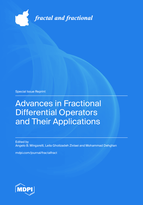Advances in Fractional Differential Operators and Their Applications
A special issue of Fractal and Fractional (ISSN 2504-3110). This special issue belongs to the section "Numerical and Computational Methods".
Deadline for manuscript submissions: closed (30 May 2023) | Viewed by 25217
Special Issue Editors
Interests: celestial mechanics; spectral theory of differential operators; fuzzy cellular automata; irrationality questions in number theory
Special Issues, Collections and Topics in MDPI journals
Interests: functional analysis; mathematical analysis; real analysis; measure theory; differential equations
Special Issue Information
This Special Issue of Fractal and Fractional is dedicated to the theory and practice of fractional differential operators and corresponding equations. Although the field of fractional derivatives is quite old, there are still many unsolved problems, and there is much significant research left to be done. Thus, we trust that more papers in the area of hybrid fractional equations (e.g., mixed Riemann–Liouville/Caputo derivatives and other combinations of such derivatives) will be published.
The areas of focused interest are as follows:
- Generalized and fractional derivatives and integrals;
- Riemann–Liouville derivatives and integrals;
- Caputo derivatives and integrals;
- Spectral and asymptotic theory;
- Qualitative theory;
- Variational principles;
- Applications of fractional derivatives to any area of the science or the humanities.
We are calling on experts in this field to contribute their significant research to this Special Issue so that it can be used to lay the groundwork for future research in the specified areas. We encourage authors to share open questions within their submissions in order to attract more attention to specific problems considered of importance. The submission deadline is December 31, 2022.
Prof. Dr. Angelo Mingarelli
Dr. Leila Gholizadeh Zivlaei
Dr. Mohammad Dehghan
Guest Editors
Manuscript Submission Information
Manuscripts should be submitted online at www.mdpi.com by registering and logging in to this website. Once you are registered, click here to go to the submission form. Manuscripts can be submitted until the deadline. All submissions that pass pre-check are peer-reviewed. Accepted papers will be published continuously in the journal (as soon as accepted) and will be listed together on the special issue website. Research articles, review articles as well as short communications are invited. For planned papers, a title and short abstract (about 100 words) can be sent to the Editorial Office for announcement on this website.
Submitted manuscripts should not have been published previously, nor be under consideration for publication elsewhere (except conference proceedings papers). All manuscripts are thoroughly refereed through a single-blind peer-review process. A guide for authors and other relevant information for submission of manuscripts is available on the Instructions for Authors page. Fractal and Fractional is an international peer-reviewed open access monthly journal published by MDPI.
Please visit the Instructions for Authors page before submitting a manuscript. The Article Processing Charge (APC) for publication in this open access journal is 2700 CHF (Swiss Francs). Submitted papers should be well formatted and use good English. Authors may use MDPI's English editing service prior to publication or during author revisions.
Keywords
- generalized derivatives
- Riemann–Liouville
- Caputo derivatives
- spectral theory
- asymptotic theory
- qualitative theory
- variational theorems
- applications







